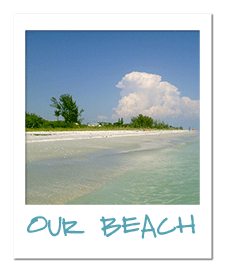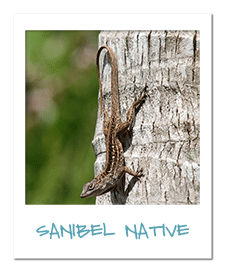About Sanibel
Sanibel is one of the few unique barrier islands of the world, having an east-west orientation when most islands are north-south. Therefore, the island has an abundance of sandy white beaches filled with fabulous shells! The Bailey-Matthews Shell Museum is the only museum in the world dedicated to the study of shells.
Sanibel Island is home to a good variety of birds, including the Roseate Spoonbill and several nesting pairs of Bald Eagles. Birds can be seen on the beaches, the causeway islands, and the reserves. Common sights include pelicans, herons, egrets and Anhingas as well as the more common birds like terns, sandpipers and seagulls. There is a population of American Alligators, and a lone rare Amerian Crocodile has been seen at the refuge as well. Plants on the island include the native sea grape, sea oats, mangroves and several types of palm trees.
The biggest wildlife refuge on the island is the J.N. "Ding" Darling National Wildlife Refuge. Covering more than 5,200 acres (21 km2) of land, the refuge strives to ensure that these lands are "preserved, restored and maintained as a haven for indigenous and migratory wildlife as part of a nation-wide network of Refuges administered by the U.S. Fish and Wildlife Service. The lands also serve to provide a home for many endangered and threatened species. Currently the refuge provides a home for over 220 species of birds native to the island. Visitors to the refuge can walk, bike, drive, or kayak though the wildlife drive which takes you through five miles (8 km) of mangrove tree forests and tidal flats, this drive is perfect for watching the island's wildlife and looking at the island's native vegetation. To show that preserving the wildlife really is important, the drive is closed one day every week, Friday, so that the wildlife can have a day to themselves where they can scavenge for food closer to the drive and not have to be bothered by or fearful of humans. There is also an education center which features "interactive exhibits on refuge ecosystems, the life and work of "Ding" Darling, migratory flyways, and the National Wildlife Refuge System."
Sanibel Island has everything one could wish for...excellent restaurants, accommodations, golfing, tennis, fishing, boating, shopping, bike paths, canoes, theatrical productions.
The City of Sanibel passed new restrictions on development after it was incorporated; these were challenged by developers, to no avail. Currently the only buildings on the island taller than two stories date before 1974, and there are no fast food or chain restaurants allowed on the island except a Dairy Queen, which was on the island before the laws were enacted. A new causeway was completed in 2007; it replaced the worn out 1963 spans, which were not designed to carry heavy loads or large numbers of vehicles. The new bridge features a "flyover" span tall enough for sailboats to pass under, replacing the old bridge's bascule drawbridge span. The original bridge was demolished and its remains were sunk into the water to create artificial reefs in the Gulf of Mexico.


